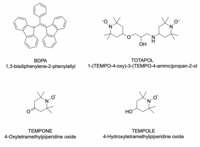Dynamic nuclear polarization

Dynamic nuclear polarization is like adding some magic dust to make nuclear magnets super powerful.
Imagine you have a group of people holding hands in a circle. Each person represents a proton in the nucleus of an atom. Normally, these protons are not very strong and can be easily knocked out of alignment.
But dynamic nuclear polarization uses a special molecule called an "electron spin Polarizing Agent". This molecule is like a superhero that can give the protons special powers.
The "superhero" molecule attaches itself to an electron in the same atom as the proton, creating a special bond. Then, a machine sends a burst of energy to the electron, which in turn transfers some of its energy to the proton. This energy boost makes the protons super strong, so they line up and point in the same direction.
Now imagine all the people in the circle holding hands tightly and pointing in the same direction like a cheerleading pyramid! That's what the protons are doing once they receive the boost from the superhero molecule.
With all the protons lined up, they create a strong magnetic field that can be used to study the atom in more detail. Scientists use this technique in various experiments and studies, such as studying the structure of molecules or improving imaging techniques, like MRI.
Imagine you have a group of people holding hands in a circle. Each person represents a proton in the nucleus of an atom. Normally, these protons are not very strong and can be easily knocked out of alignment.
But dynamic nuclear polarization uses a special molecule called an "electron spin Polarizing Agent". This molecule is like a superhero that can give the protons special powers.
The "superhero" molecule attaches itself to an electron in the same atom as the proton, creating a special bond. Then, a machine sends a burst of energy to the electron, which in turn transfers some of its energy to the proton. This energy boost makes the protons super strong, so they line up and point in the same direction.
Now imagine all the people in the circle holding hands tightly and pointing in the same direction like a cheerleading pyramid! That's what the protons are doing once they receive the boost from the superhero molecule.
With all the protons lined up, they create a strong magnetic field that can be used to study the atom in more detail. Scientists use this technique in various experiments and studies, such as studying the structure of molecules or improving imaging techniques, like MRI.
